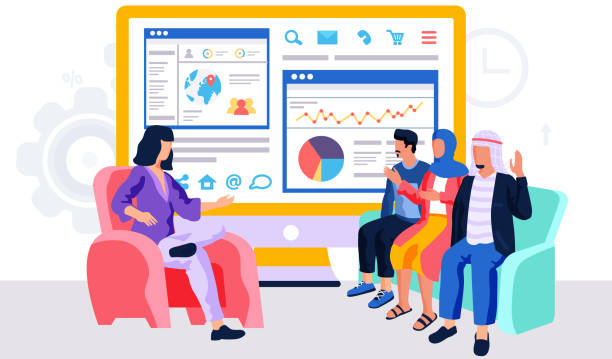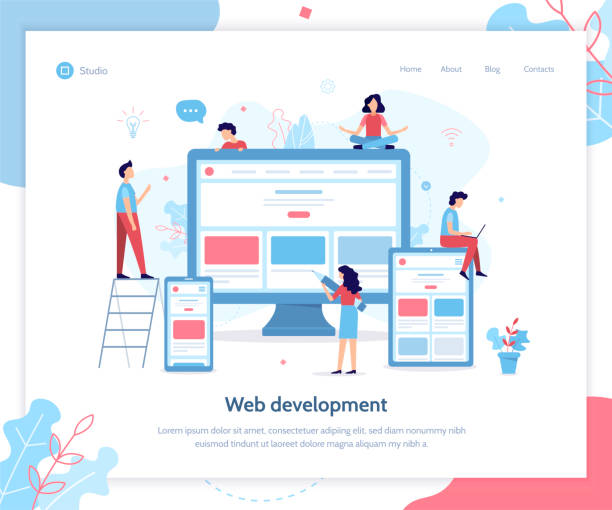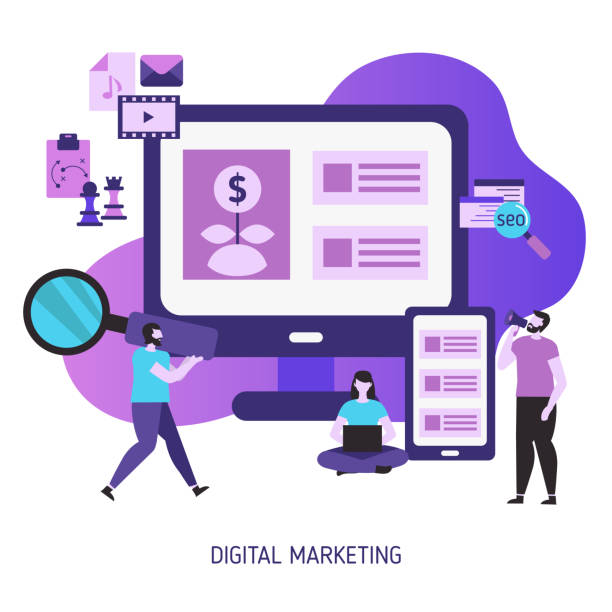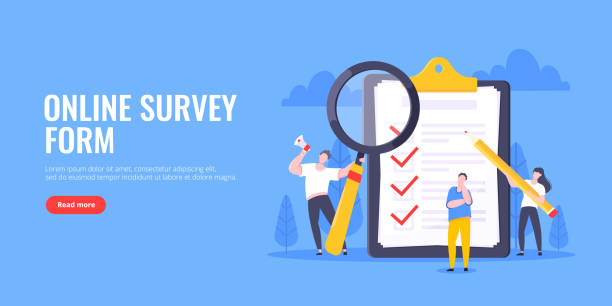Introduction and Importance of Site Speed

In today’s digital world, website loading speed is not just a competitive advantage, but a vital necessity.
Internet users, accustomed to high-speed access to information, do not tolerate delays, and numerous studies have shown that even a one-second delay in loading can mean losing a significant portion of visitors.
For this reason, #site_speed, #user_experience (UX), and #SEO_optimization have become three main pillars of online success.
The importance of this issue is such that search engines like Google consider speed as one of the key and increasingly important factors in website ranking.
This is where the concept of fast website design gains special importance; a comprehensive approach aimed at creating websites that load in the shortest possible time, provide the best possible user experience, and at the same time, achieve their commercial or informational goals.
A slow website can have serious consequences for your online presence.
These consequences include a high Bounce Rate, a sharp decrease in user engagement, and ultimately, a significant drop in Conversion Rate.
Suppose a user intends to purchase a specific product or access vital information, and your website takes longer than usual to load the product information or the desired article.
In this case, there is a very high probability that the user will leave the page without hesitation and go to your competitor or another source of information.
This scenario is not limited to e-commerce websites; blogs, news sites, educational platforms, corporate websites, and any other type of website that aims to attract and retain an audience must pay special attention to this vital issue.
Search Engine Optimization (SEO) also increasingly emphasizes site speed, as Google and other search engines strive to provide the best and fastest experience to their users, and a faster site guarantees a better user experience and will therefore rank higher in search results.
Therefore, investing in speed-enhancing factors in the site design and development process is a smart and strategic step for any business or individual operating in the online space.
In the continuation of this article, we will delve deeper into the factors affecting speed, optimization methods, and tools related to fast website design to help you build a website with excellent and successful performance.
Do you have an e-commerce site but your sales are not as expected? Rasaweb solves your problem forever with professional e-commerce website design!
✅ Significant increase in conversion rates and sales
✅ Unparalleled user experience for your customers
⚡ Click to receive free consultation with Rasaweb!
Factors Affecting Site Speed

To achieve #high_speed on a website, it is necessary to identify the various factors affecting loading time and plan for their optimization.
These factors are generally divided into two main categories: #server_side_factors and #front_end_factors.
On the server side, hosting quality, web server type (such as Apache or Nginx), and database configuration play a significant role.
A slow server or one with limited resources can be a major bottleneck for your site’s speed, even if your code is optimized.
Also, not using server-side caching or a CDN (Content Delivery Network) can increase loading times for users far from the main server.
Understanding these factors is crucial for anyone looking to achieve fast website design.
On the front-end or client side, factors such as the size of images and videos, the number and size of CSS and JavaScript files, the use of web fonts, and the complexity of the HTML structure affect site speed.
High-resolution and uncompressed images can occupy a large amount of bandwidth and significantly increase page loading time.
Large and unoptimized JavaScript and CSS files can also block page rendering and disrupt the user experience.
Furthermore, a large number of HTTP requests (each file or resource that the browser needs to load a page) can reduce speed due to communication overhead.
Using techniques such as image compression, combining and compressing CSS and JS files, and lazy loading for content outside the user’s initial view, are all important solutions for increasing site speed.
Even the choice of a Content Management System (CMS) like WordPress and its themes and plugins affects the final speed.
Therefore, a comprehensive approach to optimizing a website for speed requires attention to both server and client sides to achieve a fast and efficient website design.
Optimizing Images and Content

Images, videos, and other media files often constitute the largest portion of a web page’s size.
For this reason, #image_optimization and other visual content is one of the most effective steps towards #increasing_site_speed and achieving fast website design.
Without this optimization, even the best coding and hosting cannot guarantee optimal performance.
The first step is to choose the appropriate format for each image.
For photos, JPEG is usually the best option in terms of compression and quality, while for simple graphics, icons, and transparent images, PNG is more suitable.
Newer formats like WebP offer better compression while maintaining similar quality and can significantly reduce image file sizes.
After choosing the format, you should use compression tools.
These tools can significantly reduce file size without a noticeable loss in visual quality.
Many online and offline tools, as well as CMS plugins, are available for this purpose.
Furthermore, ensure that images are loaded in appropriate dimensions for display on your website; loading a 4000×3000 pixel image for display in an 800×600 pixel space is a waste of bandwidth.
Using “Lazy Loading” for images and videos, which causes content to load only when the user scrolls towards it, is also a very effective solution for fast website design.
This significantly reduces the initial page loading time, especially on long pages containing many images.
For text content, optimization includes using low-volume web fonts with proper caching, as well as compressing CSS and JavaScript files.
The ultimate goal is to provide a rich visual experience without compromising site performance and speed.
Table 1: Image Optimization Techniques for Site Speed
| Technique | Explanation | Impact on Speed |
|---|---|---|
| Choosing Appropriate Format | Using JPEG for photos, PNG for transparency, SVG for graphics, and WebP for higher compression. | Significant reduction in file sizes |
| Image Compression | Using tools or plugins to reduce size without compromising quality. | Traffic optimization and faster loading |
| Correct Image Dimensions | Loading images with precise dimensions as displayed on the page. | Prevents browser resizing, reduces processing |
| Lazy Loading | Loading images only when the user scrolls towards them. | Reduces initial page loading time |
| Using CDN | Distributing content on servers close to the user. | Reduces Latency in accessing images |
Choosing Suitable Host and Infrastructure

One of the most important decisions in #fast_website_design is choosing the right host and infrastructure.
Hosting is the virtual home of your website, and its quality directly affects your site’s loading speed, stability, and security.
A low-quality or unsuitable host can negate all your optimization efforts.
#Suitable_hosting should have sufficient resources (CPU, RAM, and storage space) and utilize new technologies like NVMe SSD for data storage, which significantly increases read and write speeds.
Also, the type of hosting – shared hosting, Virtual Private Server (VPS), dedicated server, or cloud hosting – should be selected according to your website’s needs and traffic volume.
For small websites with low traffic, shared hosting may suffice, but for larger projects and websites expecting high traffic, using a VPS or dedicated server is recommended.
Cloud hosting is also an excellent option for websites with variable or growing traffic due to its high scalability and pay-as-you-go model.
In addition to the type of host, the geographical location of the server is also important.
Choosing a server that is geographically closer to most of your users can reduce latency and improve loading speed.
Using a CDN (Content Delivery Network) is another essential solution for increasing website speed.
A CDN stores static content of your website (such as images, CSS, and JavaScript) on multiple, distributed servers worldwide.
When a user accesses your website, content is delivered to them from the closest CDN server, which significantly reduces loading time.
This robust infrastructure is the backbone of a fast and optimized website design.
Are your e-commerce site visitors leaving before buying? Don’t worry anymore! With Rasaweb’s professional e-commerce website design services, solve the problem of not converting visitors into customers forever!
✅ Significant increase in conversion rates and sales
✅ Unparalleled and engaging user experience
⚡ Contact us now for a free consultation!
Clean Coding and Front-End Code Optimization

The quality of front-end coding plays a pivotal role in #page_loading_speed and #website_performance.
Even with powerful hosting and optimized images, heavy, redundant, or unnecessary code can significantly slow down a site.
In the process of fast website design, the main goal should be clean and efficient coding.
This includes optimizing CSS and JavaScript files.
One of the most important techniques is “Minification” or code compression.
This process involves removing unnecessary characters such as whitespace, newlines, and comments from code files that do not directly affect website performance but increase file size.
In addition to Minification, “Concatenation” or combining files can also be beneficial.
By combining multiple CSS files into one and multiple JavaScript files into one, the number of HTTP requests that the browser must make to load a page can be reduced.
This is especially important in older protocols like HTTP/1.1.
Also, optimizing JavaScript loading is crucial.
JavaScript is by default “render-blocking,” meaning the browser must wait for all scripts to load and execute before it can display the page.
To resolve this issue, you can use the `async` and `defer` attributes in script tags.
`async` allows the browser to load the script asynchronously, while `defer` ensures that the script executes after the HTML has fully loaded.
These techniques allow the main page content to be available to the user sooner, improving the fast website design experience.
Furthermore, using CSS Sprites to combine multiple small images into a single larger image and reducing HTTP requests for icons and small graphical elements is another effective method to increase web page loading speed.
The Role of Themes and Plugins in Site Speed

In Content Management Systems (CMS) like WordPress, Joomla, or Drupal, #themes and #plugins play a crucial role in the appearance and functionality of a website.
However, their improper selection can significantly impact site speed and render our efforts for fast website design futile.
A heavy theme full of unnecessary features that contain extra code, large JavaScript files, and complex CSS can drastically increase page loading time.
Some themes are designed to provide great flexibility, and this flexibility often means adding more code that may never be used but is still loaded.
Plugins, like themes, can be both beneficial and detrimental.
While plugins add new functionalities to a website (such as contact forms, SEO optimization, or caching), each plugin adds additional CSS, JavaScript, and sometimes database requests to your website.
Installing too many plugins or using poorly coded plugins can slow down your website.
To maintain high site speed, it is recommended to:
- Choose lightweight and optimized themes: Look for themes designed for speed and high performance.
Minimalist themes are usually a better option. - Remove unnecessary plugins: Regularly review installed plugins and remove those you don’t use or have lighter alternatives.
- Check plugin performance: Before installing a new plugin, check user reviews and its impact on site speed.
Some caching or image optimization plugins can help increase speed, but their selection should also be done carefully. - Regular updates: Updated themes and plugins typically include performance and security improvements.
By carefully selecting and managing themes and plugins, you can achieve a fast website design that has both an attractive appearance and excellent performance.
Speed Test Tools and Results Analysis

After applying optimization methods, the next step to ensure #optimal_site_speed and success in #fast_website_design is to measure and evaluate performance.
Numerous online tools exist to help you measure your website’s loading speed, identify bottlenecks, and receive recommendations for improvement.
These tools provide a comprehensive view of your site’s performance by simulating real visitors and measuring various metrics.
Among the most popular and reputable of these tools are Google PageSpeed Insights, GTmetrix, and Pingdom Tools.
Each of these tools has its own specific metrics and recommendations:
- Google PageSpeed Insights: Provides a score from 0 to 100 for site performance on mobile and desktop devices and offers specific recommendations for speed improvement based on Google’s Core Web Vitals.
This tool focuses more on actual user experience. - GTmetrix: Provides a deeper analysis and includes Waterfall reports (to see the loading time of each request), performance history, and detailed recommendations based on Best Practices.
This tool is very useful for professional developers and optimizers. - Pingdom Tools: Has a simple user interface and is suitable for measuring overall loading time, page size, and the number of requests.
This tool also offers various geographical locations for speed testing.
Analyzing the results of these tools requires understanding key concepts such as “First Contentful Paint (FCP)”, “Largest Contentful Paint (LCP)”, “Cumulative Layout Shift (CLS)”, “Time to Interactive (TTI)”, and “Total Blocking Time (TBT)”, all of which are considered Core Web Vitals.
By correctly interpreting these metrics and implementing the recommended suggestions, you can continuously monitor and improve your website’s speed and achieve a fast and successful website design.
This continuous monitoring and optimization process is an integral part of managing a high-speed website.
Table 2: Common Website Speed Test Metrics and Their Meanings
| Metric | Explanation | Importance for User Experience |
|---|---|---|
| FCP (First Contentful Paint) | Time until the first contentful element (text, image) is displayed on the page. | Initial sense of speed and that the page is loading. |
| LCP (Largest Contentful Paint) | Time until the largest visible content element in the Viewport is loaded. | Indicates when the main part of the content is ready for the user. |
| CLS (Cumulative Layout Shift) | Amount of unexpected visual layout shifts on the page during loading. | Visual stability and prevention of accidental clicks. |
| TTI (Time to Interactive) | Time until the page is fully interactive and responsive to user input. | Ability to interact with the page without delay and freezing. |
| TBT (Total Blocking Time) | The sum of all periods when the main thread is blocked from responding to user input. | No delay in responding to user input. |
Impact of Site Speed on SEO and User Experience

As previously mentioned, #site_speed is no longer just a benefit, but has become a #vital_factor in search engine rankings and also #user_experience (UX).
Google has explicitly stated that page speed, especially Core Web Vitals metrics, is an important factor in their ranking algorithm.
Websites that provide a fast and smooth user experience not only have a higher chance of ranking well in search results but also have a lower bounce rate.
Consequently, for any online business and individual seeking visibility on the web, fast website design should be a priority.
Core Web Vitals consist of three main metrics: Largest Contentful Paint (LCP), Cumulative Layout Shift (CLS), and First Input Delay (FID), which later changed to Interaction to Next Paint (INP).
These metrics score not only based on loading speed but also on the user’s visual and interactive experience.
A slow site can cause users to leave before the page fully loads (high Bounce Rate).
This signals to search engines that your content was not engaging or accessible enough for the user.
In contrast, a fast site encourages users to stay on the site longer, visit more pages, and increases the likelihood of actions such as purchasing, signing up, or reading more articles.
This brings positive results not only for fast website design but also for your business.
Site speed is directly related to the Conversion Rate; the faster the site, the easier users can achieve their goals, and consequently, the conversion rate improves.
Therefore, optimizing site speed is a smart investment that strengthens your SEO and significantly improves the user experience.
Do you know that your company’s website is the first point of contact for 75% of potential customers?
Your website is the face of your brand. With **Rasaweb**’s corporate website design services, build an online presence that gains customer trust.
✅ Create a professional and lasting image for your brand
✅ Attract target customers and increase online credibility
⚡ Get free consultation from **Rasaweb** experts now!
Advanced Tips and Challenges of Fast Website Design
![]()
Achieving #peak_speed on a website goes beyond basic optimizations and requires #advanced_techniques and confronting #specific_challenges.
One such technique is implementing Server-side Caching.
This type of caching allows the server to store prepared versions of web pages and, on subsequent requests, deliver the cached version to the user immediately instead of rebuilding the entire page.
This is particularly effective for websites with high traffic or static content.
Systems like Redis or Memcached can also increase database access speed, which is a significant factor in fast website design.
Another challenge is database optimization.
Large and fragmented databases can increase server response time.
Regularly cleaning the database of redundant data, optimizing table structures, and using indexes for frequently used queries can significantly improve database performance.
Also, using HTTP/2 or even HTTP/3 (QUIC) instead of HTTP/1.1 can increase loading speed by enabling parallel request sending (Multiplexing) and header compression.
These new protocols are highly efficient, especially for websites with a large number of requests, and play an important role in increasing site speed and user experience.
Additionally, optimizing web fonts, including using WOFF2 formats and loading only necessary subsets (Subsetting), can reduce font file sizes.
Managing third-party scripts (such as tracking codes, advertisements, and analytical tools) is also a major challenge; these scripts are often beyond our control and can unintentionally slow down the site.
Using lazy loading for these scripts or executing them after the page has fully loaded are solutions to reduce their negative impact on fast website design and overall site performance.
Future of Fast Website Design and New Trends

The web world is constantly evolving, and with the emergence of new technologies, #fast_website_design approaches are also evolving.
The future of web speed not only focuses on current optimizations but also seeks innovations that will elevate the user experience to unprecedented levels.
One of the most important future trends is the widespread adoption of #Progressive_Web_Apps (PWA).
PWAs offer a combination of the best features of the web and native applications; they are installable on the user’s device, can work offline, and provide a very fast and smooth experience.
This technology has high potential for transforming fast website design and accessibility.
Another trend is the continuous advancement in web standards and protocols such as HTTP/3, which is built on the QUIC protocol and promises further latency reduction and improved performance on unstable networks.
These protocols form the foundation of a high-speed web.
Additionally, we are witnessing an increasing use of Server-Side Rendering (SSR) and Static Site Generation (SSG) techniques, which prepare HTML content before sending it to the user’s browser, drastically reducing initial loading time.
These approaches are very effective, especially for content-driven sites.
Artificial intelligence and machine learning may also play an important role in automatic website optimization in the future; for example, by predicting user behavior and loading necessary resources before they are requested.
Ultimately, focusing on fast website design means paying attention to the growing needs and expectations of users who seek instant access to information and services.
This forward-looking perspective will define the direction of web development in the coming years.
Frequently Asked Questions
| No. | Question | Answer |
|---|---|---|
| 1 | What is the concept of “Fast Website Design”? | Designing a website that loads in the shortest possible time and provides a smooth user experience, with an emphasis on performance optimization. |
| 2 | Why is site loading speed important for users? | Today’s users have little patience; slow sites lead to early page abandonment, undesirable user experience, and loss of visitors. |
| 3 | What impact does fast website design have on SEO? | Search engines like Google consider site speed as one of their ranking factors. Faster websites achieve better rankings in search results. |
| 4 | What are the main factors affecting site speed? | Image optimization, caching, compression of CSS and JS files, using powerful hosting, reducing HTTP requests, and optimized coding. |
| 5 | How can website loading speed be measured? | By using tools such as Google PageSpeed Insights, GTmetrix, Lighthouse, and Pingdom Tools that provide detailed reports on site performance. |
| 6 | What is the role of images in site speed and how should they be optimized? | High-volume images can significantly reduce site speed. They should be compressed, modern formats (like WebP) should be used, and Lazy Load technique should be employed. |
| 7 | What is the importance of choosing appropriate hosting in fast website design? | A powerful and high-speed hosting (preferably SSD) with optimized servers close to target users is the foundation of a site’s speed. |
| 8 | How does Caching help increase site speed? | Caching allows the user’s browser to store copies of site files, so on subsequent visits, there is no need to reload all content, and the site displays faster. |
| 9 | Is using a CDN (Content Delivery Network) recommended in fast website design? | Yes, a CDN significantly increases loading speed by storing copies of site content on various geographical servers and delivering it from the closest server to the user. |
| 10 | What are the key tips for developers to design a high-speed website? | Writing clean and optimized code, minimal use of plugins, optimizing database queries, using lightweight frameworks, and implementing Lazy Load for content. |
And other services of Rasa Web advertising agency in the field of advertising
How to use advanced AI advertising for HVAC equipment
The role of integrated advertising in increasing brand credibility for HVAC equipment
Reviewing the impact of interactive advertising on attracting commercial HVAC customers
How to use optimized text ads for HVAC vendors
The importance of brand-focused video advertising in global HVAC markets
And over hundreds of other services in the field of internet advertising, advertising consulting, and organizational solutions
Internet Advertising | Advertising Strategy | Advertorials
🚀 With Rasaweb Afarin, your business takes flight in the digital world! We provide services such as secure website design, Search Engine Optimization (SEO), and targeted advertising campaigns to create a powerful and lasting online presence for your brand.
📍 Tehran, Mirdamad Street, next to Bank Markazi, Kazerun Jonoubi Alley, Ramin Alley, No. 6

